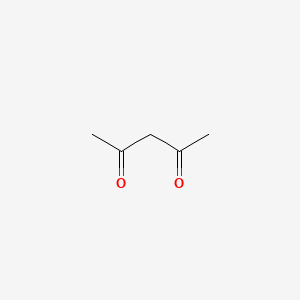| MeSH term | MeSH ID | Detail |
|---|---|---|
| Adenocarcinoma | D000230 | 166 associated lipids |
| Body Weight | D001835 | 333 associated lipids |
| Dermatitis, Contact | D003877 | 59 associated lipids |
| Eczema | D004485 | 4 associated lipids |
| Edema | D004487 | 152 associated lipids |
| Fetal Resorption | D005327 | 15 associated lipids |
| Glioma | D005910 | 112 associated lipids |
| Nervous System Diseases | D009422 | 37 associated lipids |
| Purpura, Thrombocytopenic | D011696 | 2 associated lipids |
| Seizures | D012640 | 87 associated lipids |
2,4-pentanedione
2,4-pentanedione is a lipid of Fatty Acyls (FA) class. The related lipids are Butyrates.
Cross Reference
Introduction
To understand associated biological information of 2,4-pentanedione, we collected biological information of abnormalities, associated pathways, cellular/molecular locations, biological functions, related genes/proteins, lipids and common seen animal/experimental models with organized paragraphs from literatures.
What diseases are associated with 2,4-pentanedione?
There are no associated biomedical information in the current reference collection.
Possible diseases from mapped MeSH terms on references
We collected disease MeSH terms mapped to the references associated with 2,4-pentanedione
PubChem Associated disorders and diseases
What pathways are associated with 2,4-pentanedione
There are no associated biomedical information in the current reference collection.
PubChem Biomolecular Interactions and Pathways
Link to PubChem Biomolecular Interactions and PathwaysWhat cellular locations are associated with 2,4-pentanedione?
There are no associated biomedical information in the current reference collection.
What functions are associated with 2,4-pentanedione?
There are no associated biomedical information in the current reference collection.
What lipids are associated with 2,4-pentanedione?
Related references are published most in these journals:
| Lipid concept | Cross reference | Weighted score | Related literatures |
|---|
What genes are associated with 2,4-pentanedione?
There are no associated biomedical information in the current reference collection.
What common seen animal models are associated with 2,4-pentanedione?
There are no associated biomedical information in the current reference collection.
NCBI Entrez Crosslinks
All references with 2,4-pentanedione
Download all related citations| Authors | Title | Published | Journal | PubMed Link |
|---|---|---|---|---|
| Lozada-GarcÃa RR et al. | Photochemistry of acetylacetone isolated in parahydrogen matrices upon 266 nm irradiation. | 2012 | Phys Chem Chem Phys | pmid:22307583 |
| Park H et al. | Fe(II) complexes that mimic the active site structure of acetylacetone dioxygenase: O2 and NO reactivity. | 2012 | Inorg Chem | pmid:22974346 |
| Aronne A et al. | Use of a new hybrid sol-gel zirconia matrix in the removal of the herbicide MCPA: a sorption/degradation process. | 2012 | Environ. Sci. Technol. | pmid:22191434 |
| Åšwiderek K et al. | A theoretical study of carbon-carbon bond formation by a Michael-type addition. | 2012 | Org. Biomol. Chem. | pmid:22722380 |
| Sivagnanam SK et al. | Chemotherapeutic Efficacy of Indigofera aspalathoides on 20-Methylcholanthrene-Induced Fibrosarcoma in Rats. | 2012 | ISRN Pharmacol | pmid:22530134 |
| Al-Etaibi AM et al. | One-pot synthesis of disperse dyes under microwave irradiation: dyebath reuse in dyeing of polyester fabrics. | 2012 | Molecules | pmid:22491676 |
| Page SA et al. | A descriptive study of chiropractors' opinions and practices regarding office-based health product sales. | 2012 | Chiropr Man Therap | pmid:22480278 |
| Sugawara K et al. | Voltammetric sensing of phosphoproteins using a gallium(III) acetylacetonate-modified carbon paste electrode. | 2012 | Anal Sci | pmid:22451365 |
| MartÃnez A et al. | Searching for new chemotherapies for tropical diseases: ruthenium-clotrimazole complexes display high in vitro activity against Leishmania major and Trypanosoma cruzi and low toxicity toward normal mammalian cells. | 2012 | J. Med. Chem. | pmid:22448965 |
| Guo FS et al. | Polynuclear and polymeric gadolinium acetate derivatives with large magnetocaloric effect. | 2012 | Inorg Chem | pmid:22145780 |
